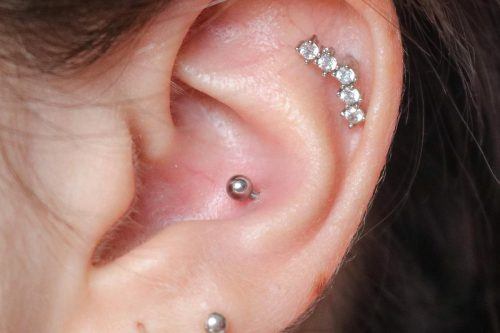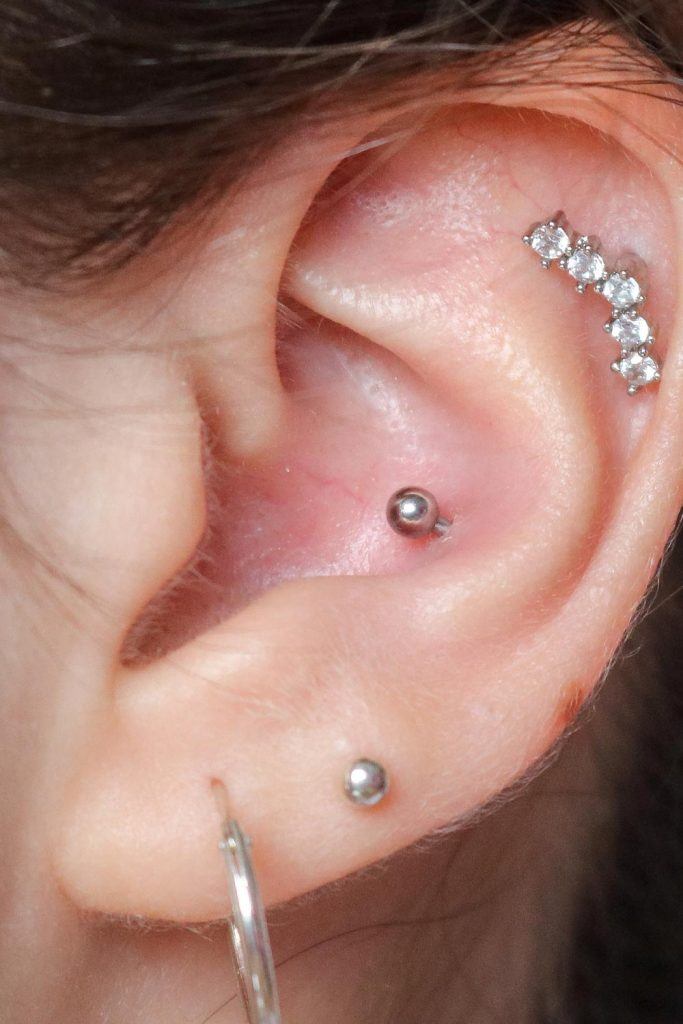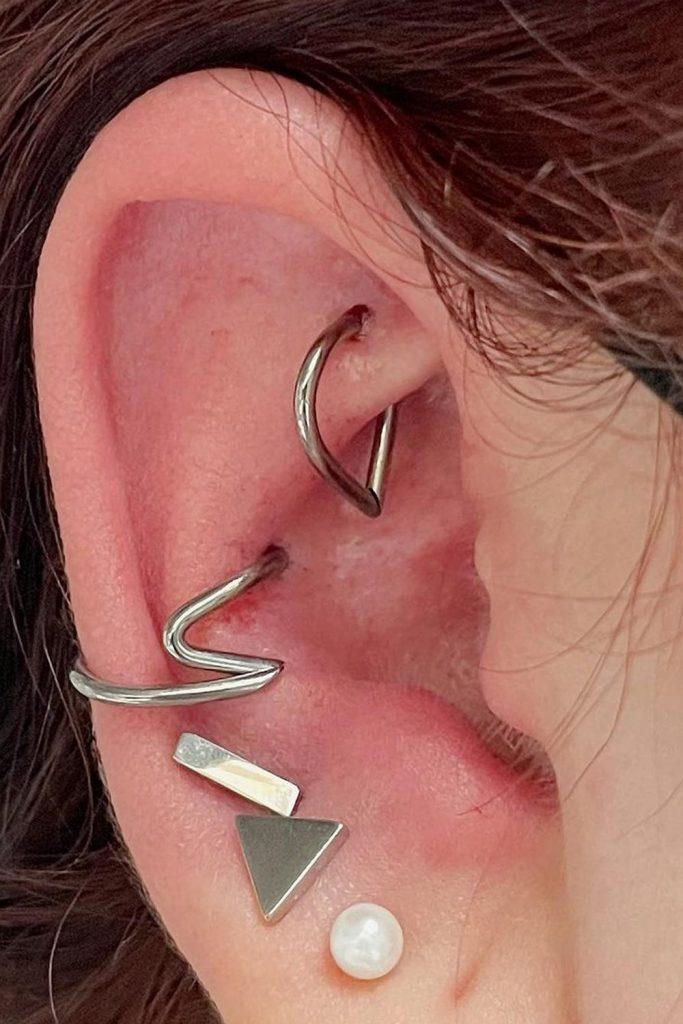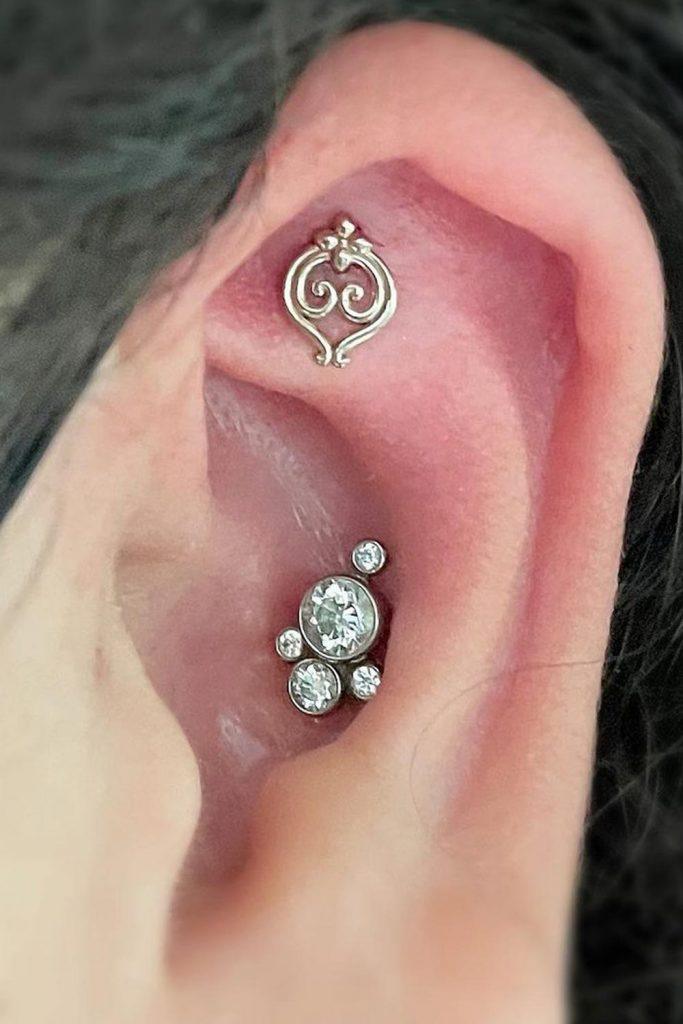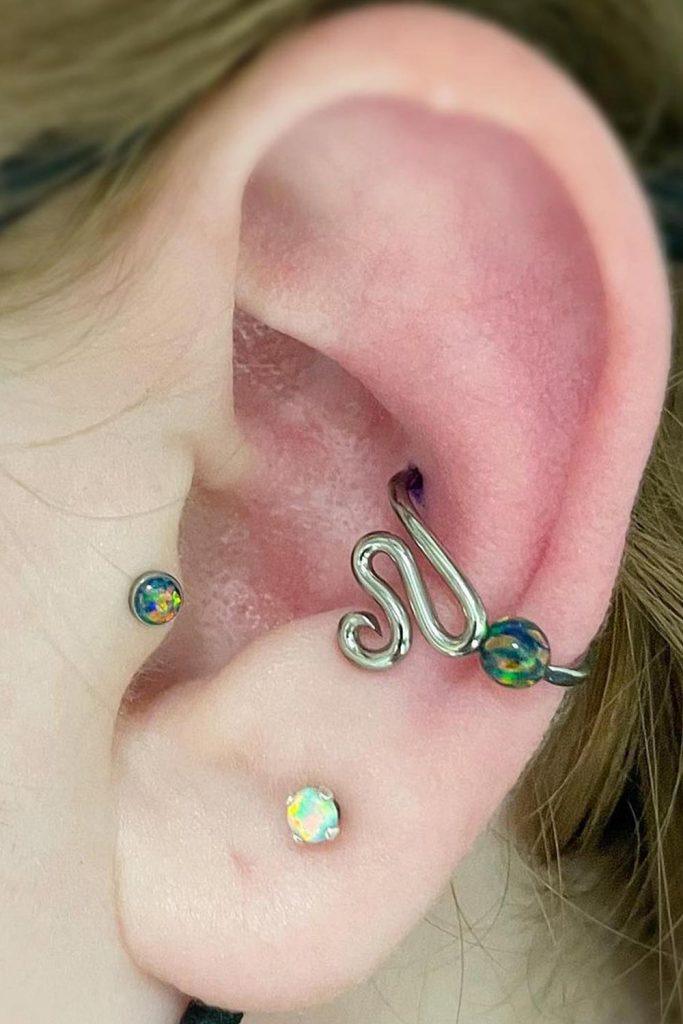The popularity of conch piercing is growing day after day, which comes as no surprise. This is a great way to stand out in the crowd and express your individuality. If you only consider getting your conch pierced, then you may have a lot of questions and doubts. No worries. Our guide will back you up. We have covered every aspect that you need to know before venturing out for a conch ear piercing, from what it is to the most popular jewelry options. So, study it carefully and get ready to upgrade your curated ear.
What The Hey Is Conch Piercing?
If you have no idea of what is a conch piercing, we will give you a quick heads up. This is a piercing type where you get the inside of your ear pierced. Because it looks like the shell of a conch, this ear part is referred to as a conch. And when you puncture it with a needle and insert an earring into the hole, it is called a conch piercing. Unlike other types of piercing, it can be customized in a wide variety of ways. A conch ear piercing may imply a piercing in either or both parts of your conch – outer and/or inner. The choice usually depends on the ear shape you have and your personal preference.
When you get the ear middle pierced and insert a stud in it, it is referred to as the inner conch piercing. If your lower part of the cartilage is punctured, it is known as the outer conch piercing, which usually calls for a conch piercing hoop. When your ear anatomy allows for enough room on both parts of your ear, you can get a double conch piercing.
When you get the ear middle pierced and insert a stud in it, it is referred to as the inner conch piercing. If your lower part of the cartilage is punctured, it is known as the outer conch piercing, which usually calls for a conch piercing hoop. When your ear anatomy allows for enough room on both parts of your ear, you can get a double conch piercing.
How To Choose Conch Piercing Jewelry?
Credit photo: Instagram.com/noahbabcockBecause there are so many conch piercing jewelry options on the market nowadays, you may find choosing the right earring a bit overwhelming. The main things that you should consider are the shape of the earring, the material it is made of and the price. For your convenience, we have broken down all the necessary information about how to choose jewelry for piercing.
It’s all about the Shapes
- Conch piercing hoop. If you are looking for an option that would look reserved and stylish while being comfortable to wear, then a conch piercing hoop is your way to go.
- Conch piercing stud. Studs are one of the most popular earrings for conch piercings. They come in many styles and work for both outer and inner conch. They can be straight and curved, plain and intricate, solid and with diamonds or rhinestones, everyone will find a conch piercing stud to their taste.
- Forward helix conch piercing. If you consider a forward helix conch piercing, then you will be choosing between flat back studs and tiny cartilage hoops. Pay attention, however, that your piercing may get irritated with the latter.
- Orbital Conch piercing. The most common type of jewelry used for an orbital conch piercing is a hoop. Yet, other options are also possible, such as studs, bars, etc.
- Conch piercing ring. You can never go wrong with a conch piercing ring. It is convenient, practical and pretty. Besides, it can go for any conch piercings type.
Everything's material…
When it comes to the conch piercing material, you are offered multiple options as well. Here are the most common of them:
- Surgical Stainless Steel. SSS, which stands for surgical stainless steel is the most popular material for piercing and no wonder. It does not cause allergies nor does it cost you an arm and a leg. Look for grade 316L or 316LVM.
- If you are allergic to nickel, then SSS may not work for you. And that is when implant grade titanium comes into play. Your body does not treat it as a foreign body, so it will not try to push it out. Though, it usually comes with a bigger price tag.
- The cost of niobium is the golden mean between titanium and surgical stainless steel. It is not rejected by our body as well while offering you much versatility. Mind though that 999 Niobium or 99.9% niobium is your best choice.
- 14K/18K Gold. Gold clearly needs no introduction. But it is important to make sure you deal with high quality gold. Wearing jewelry made of some composition metals containing only small quantities of gold may result in irritated or even infected piercing. Besides, they easily lose their presentable appearance. So that it will not happen, you should choose 14K or 18K gold.
- If you have a few dollars to spare, then you may want to go with platinum jewelry for conch piercings. While it may seem a bit overpriced at first, it is a wise investment. Platinum does not cause irritation and allergies, as it is biocompatible, so your body will not reject it. And it goes without saying that it looks stunning.
- Pure Silver. Those who are not particularly keen on yellow metals may want to lean toward sterling silver. While it is more affordable than gold and platinum, it also does not cause allergies. Yet, this is only applicable to pure silver, also known as fine silver. If it contains additives, such as copper, your skin may not tolerate it. So, choose jewelry that contains 99.9% of silver.
How much does it cost?
There are conch piercings choices for every price point, from quite budget friendly to high priced. When calculating the price, you should factor in both the cost of the service and the jewelry. The service price, in its turn, may vary depending on the level of expertise of the piercer, the location of the salon, the number of piercings you want to get, etc. That said, an average conch piercings price ranges between $40 and $100.
Does Conch Piercing Hurt?
Credit photo: Instagram.com/noahbabcockIf you are worried that conch piercing pain will be intolerable, it is very individual. It greatly depends on your pain threshold. As a conch piercing implies puncturing the cartilage, not soft tissue, it will hurt more than when getting your lobes pierced. However, if you compare it to the helix piercing, the pain from conch piercings will be more or less the same.
As the piercer will push the needle through your conch, there will be a pressing and acute pain in it. During the first few days of the healing process, the ear will feel sore and the pain will be throbbing. To alleviate your suffering, experts advise avoiding sleeping on the side where you got the ear pierced and keeping your hands away from it during the day. Also, make sure to follow the piercer’s aftercare recommendations.
Healing Period
Credit photo: Instagram.com/noahbabcockHealing period. Of course, you want to know when you will be able to play around with different jewelry options and generally how soon your pierced conch will no longer hurt. So, how long does a conch piercing take to heal? According to UWHealth, an average conch healing time is between 6 and 9 months. Yet, depending on various factors, it can heal faster or longer.
Precautions and safety measures. The most effective way to aid the healing process is taking proper care of your piercing. It requires regular cleaning using a special solution (either soap or salt water). Also, do not touch it or otherwise move it, as it can easily get infected or traumatized.
Conch Piercing Aftercare
Credit photo: Instagram.com/noahbabcockThe key to successful and fast healing is proper conch piercing aftercare. So, here are the main tips on how to take care of your freshly pierced conch:
- Choose the jewelry that facilitates the healing process. Studs are a better option when it comes to the type of jewelry to wear in your pierced ear during its healing. Hoops and rings may get stuck in your clothes, hair and other stuff, thus traumatizing the piercing. So, it is better to leave them for later.
- Steer clear of blood thinners. As your piercing may ooze with blood when it is beginning to heal, you should not eat or drink anything that makes your blood thinner, like aspirin, alcohol or even much caffeine.
- Try to avoid getting your piercing infected. Bacteria can get into your new piercing in many different ways. But the most common source of piercing infection is fingers. So, you should not let anyone touch your piercing and when you do it yourself, either make sure your hands are sterile clean or put on gloves. Also, avoid visiting the swimming pool and other places where the water is communal. The hot tub should also be postponed. If you happen to bring an infection to the piercing, then the first thing you should do is to see your piercer. They will examine the infected conch piercing and tell you what to do next.
- Wait for the piercing to heal before changing the jewelry. While it is pretty obvious that you want to try on different piercing jewelry styles for your new conch piercing, you should not jump the gun. Allow your piercing to heal completely first and then only you may take it out. This usually requires from six months to a full year, so be patient.
- Apply a special spray to expedite the process of healing. You should clean the piercing more than once daily with a piercing spray containing saline. It will help you to get rid of discharge and the secretions of dried lymph. Use a cotton pad to apply the solution or spritz it right from the bottle.
Now that you have all the information about conch piercing, you should not worry about getting it. You know what they say, feel the fear but do it anyway. Just follow the tips we have given you above and it will not take long until you will be able to flaunt a new piercing in your conch.
FAQ: Conch Piercing
Is the conch The most painful piercing?
Move your ear around and feel it. The cartilage in the conch is thicker and harder than the cartilage in the rest of your ear, which means this piercing will hurt a bit more than piercings in other parts of your body, such as your earlobe.
Can you sleep on a conch piercing?
For side sleepers, it’s better not to sleep the piercing side until it is completely healed. Many piercers agree that sleeping on piercings can cause irritation and slow down the healing process. So, it is recommended to lie on your back with or without conch piercings.
What does a conch piercing help with?
Conch piercing is reportedly targeted at acupuncture points that help relax the muscle. In addition, these clam piercings are associated with the ability to manage chronic pain.
Was this article helpful?



